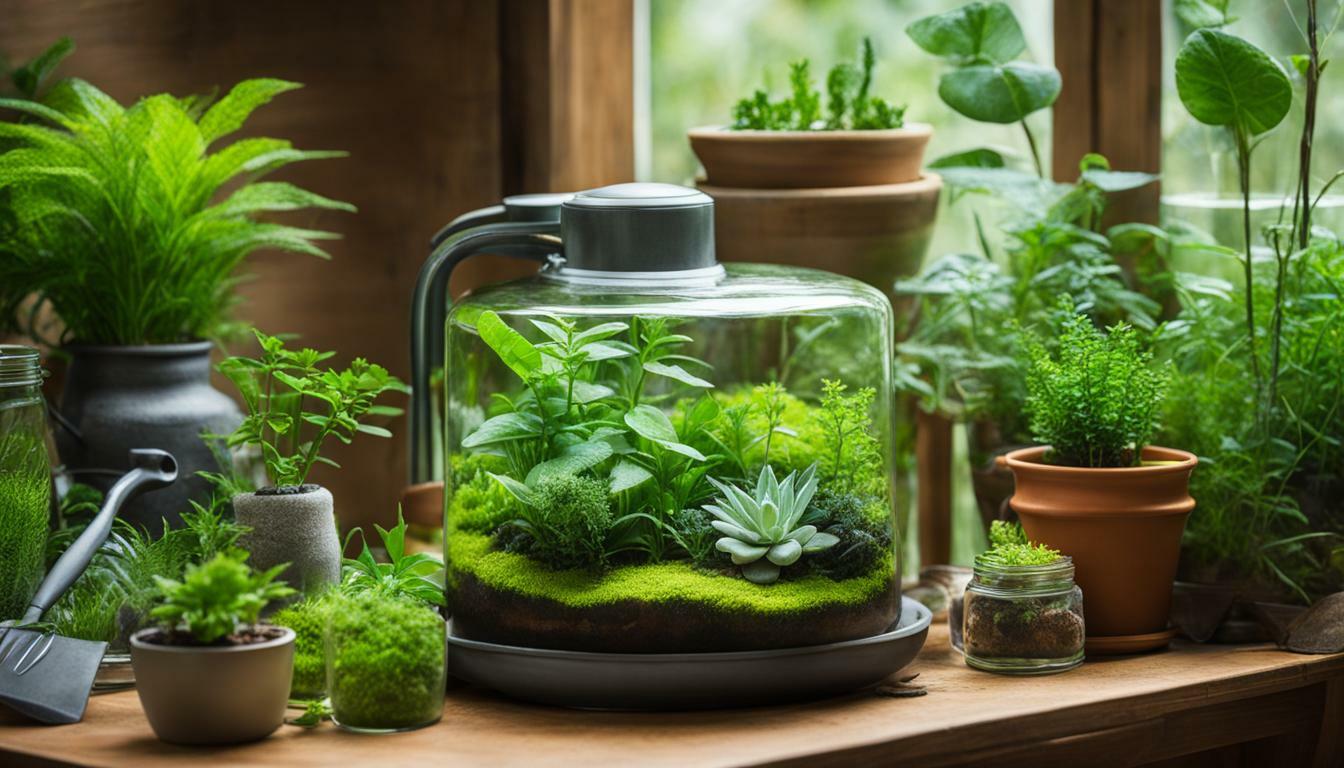Welcome to our comprehensive guide to terrarium care and water feature care. Whether you’re a beginner or experienced enthusiast, we’ll provide you with expert tips and insights to help you maintain the beauty and health of your terrariums and water features.
- Mastering terrarium care requires attention to humidity levels, watering practices, lighting conditions, and prevention of mold growth.
- Check the humidity by observing condensation on the terrarium glass.
- Avoid overwatering and use a mister or spray bottle for watering.
- Provide the terrarium with sufficient but not excessive bright indirect light.
- Control mold growth by increasing airflow, wiping with hydrogen peroxide or chamomile tea, and introducing springtails as a preventive measure.
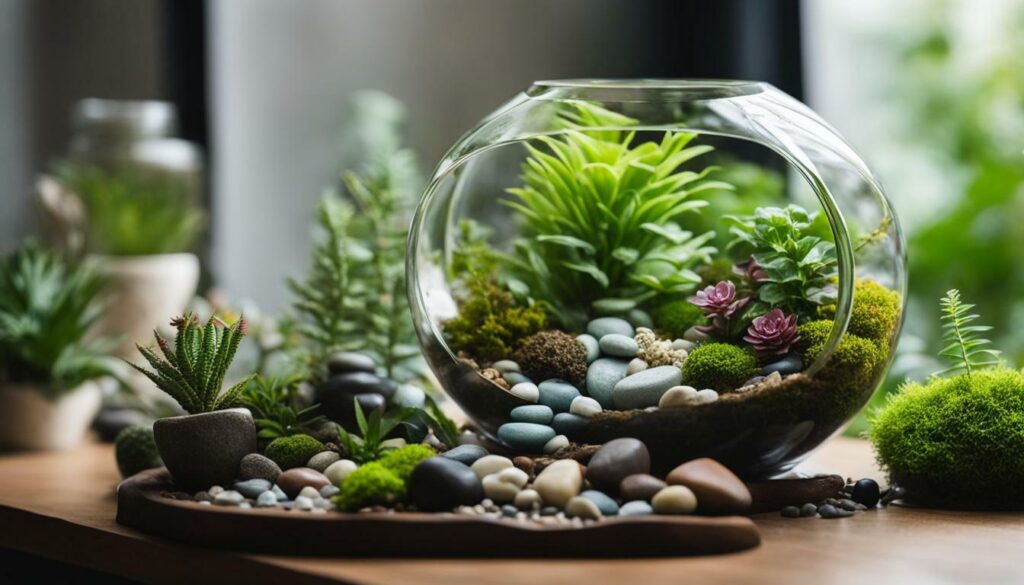
Checking Humidity Levels
Maintaining the right humidity levels is crucial for the health and vitality of your terrarium. By observing the condensation on the terrarium glass, you can determine if the humidity is at an optimal level. Condensation on the glass indicates a high humidity level, which is generally desirable for most terrarium setups. However, if there is excessive condensation or water droplets constantly forming on the glass, it may indicate that the humidity is too high and needs to be reduced.
On the other hand, if there is no condensation or very minimal condensation on the glass, it means that the humidity is low and needs to be increased. To increase humidity, you can mist the terrarium with water or place a small tray of water inside the enclosure. This will help create a humid environment within the terrarium, which is beneficial for tropical plants and moisture-loving species.
Monitoring humidity levels is especially important when it comes to closed terrariums, as they rely on a sealed environment to maintain the ideal moisture balance. It is recommended to check the condensation on the glass regularly and adjust the humidity accordingly to ensure the well-being of your terrarium plants and inhabitants.

Here’s a handy table summarizing the different humidity levels and their corresponding condensation on the terrarium glass:
| Humidity Level | Condensation on Terrarium Glass |
|---|---|
| Low | No condensation or minimal condensation |
| Medium | Occasional condensation or small water droplets |
| High | Consistent condensation or large water droplets |
Remember, maintaining the right humidity levels is just one aspect of proper terrarium care. In the next section, we will delve into essential watering practices to ensure the health and longevity of your terrarium.
Watering Practices
Watering your terrarium correctly is essential to prevent waterlogging and ensure the well-being of your plants. In this section, we’ll explore the best watering practices for terrarium care.
One of the most common mistakes in terrarium care is overwatering. Excess water can lead to root rot and other moisture-related issues. To avoid this, it’s important to provide your terrarium with the right amount of water. A good rule of thumb is to water your terrarium only when the soil feels dry to the touch, about 1-2 inches below the surface. Remember, it’s better to underwater than to overwater.
When watering your terrarium, it’s best to use a mister or spray bottle rather than pouring water directly onto the plants or substrate. This allows for better control and helps prevent the soil from becoming waterlogged. Aim to mist the terrarium lightly, ensuring that the water reaches the roots without saturating the entire terrarium.
Additionally, it’s important to pay attention to the specific watering needs of your terrarium plants. Some plants may require more frequent watering, while others may thrive with less. Research the watering requirements of the plants in your terrarium and adjust your watering schedule accordingly.
Table: Recommended Watering Practices for Terrarium Care
| Plant Type | Watering Frequency | Watering Amount |
|---|---|---|
| Succulents and Cacti | Every 2-4 weeks | Sparingly, allowing soil to dry between waterings |
| Tropical Plants | Every 1-2 weeks | Lightly moistening the soil |
| Mosses and Ferns | Every 1-2 days | Keeping soil consistently moist, but not waterlogged |
By following these watering practices and tailoring them to the specific needs of your terrarium plants, you can ensure optimal care and create a thriving ecosystem within your terrarium.
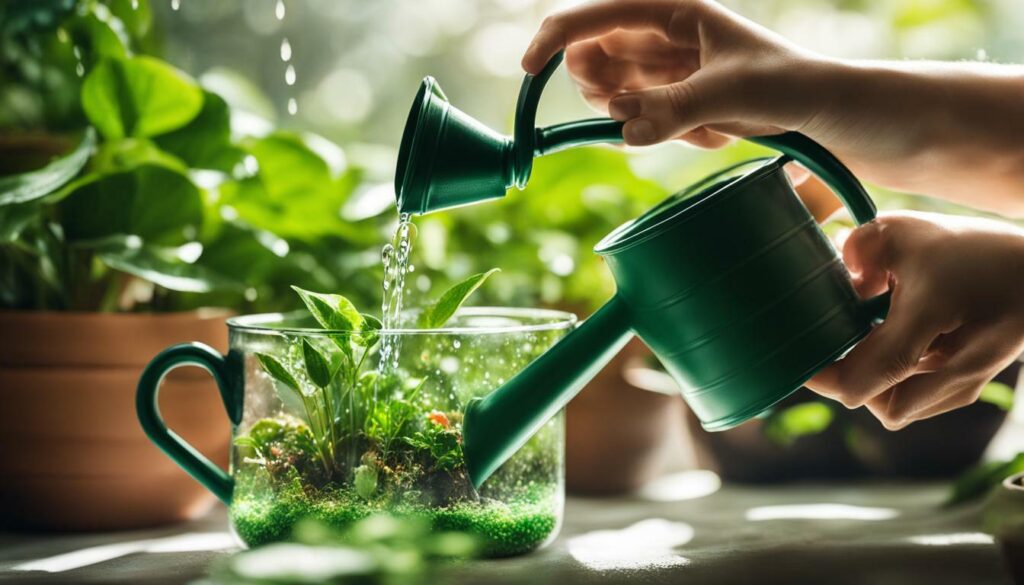
Remember, maintaining proper watering practices is just one aspect of successful terrarium care. In the next sections, we’ll explore other essential aspects such as lighting conditions, mold prevention, and plant maintenance to help you master the art of terrarium care.
Lighting Conditions
Creating the ideal lighting conditions for your terrarium is crucial for the growth and development of your plants. Let’s explore the best practices for providing the right amount of light.
When it comes to terrarium lighting, bright indirect light is generally preferred. Placing your terrarium near a north or east-facing window can provide the perfect balance of light without exposing your plants to harsh direct sunlight.
It’s important to understand that different plants have different lighting requirements. Some may thrive in low-light conditions, while others may need more intense light. Researching the lighting needs of the specific plants in your terrarium will help ensure their success.
As a general rule, it’s best to avoid placing your terrarium in areas with inconsistent or extreme temperatures. Direct sunlight through a window can create hot spots, causing your terrarium to overheat. Conversely, placing your terrarium near drafts or air conditioning vents can lead to temperature fluctuations that may stress your plants.
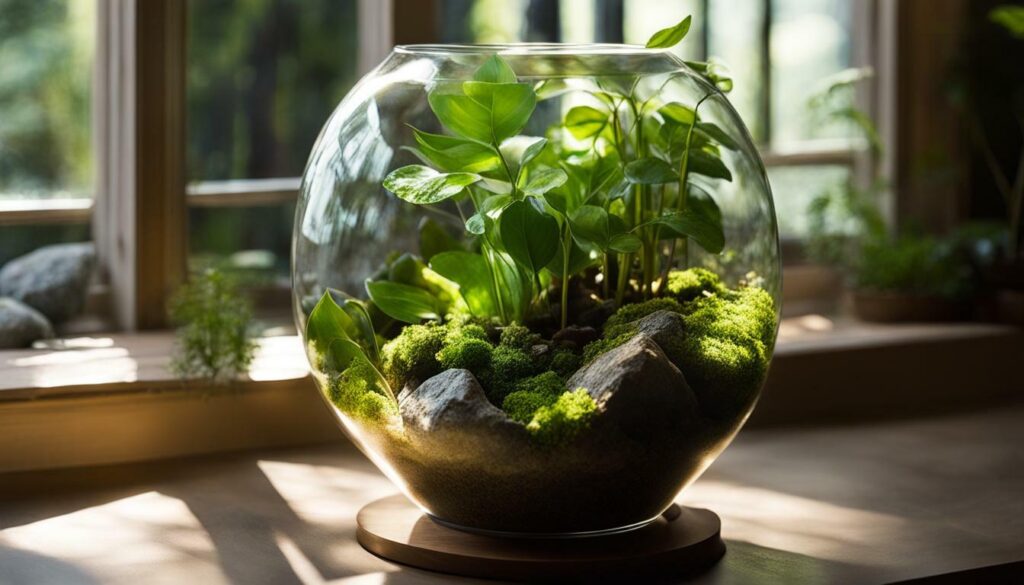
| Lighting Tips | Benefits |
|---|---|
| Rotate your terrarium regularly | Ensures even light distribution and prevents plants from leaning towards the light source |
| Use a grow light | Helps supplement natural light and provides adequate light for plants with high light requirements |
| Avoid placing terrariums near heat sources | Prevents overheating and damage to the plants |
| Monitor foliage color | Pale or yellowing foliage may indicate insufficient light, while browning or scorching can signal too much light |
| Consider a light timer | Helps maintain a consistent light cycle, especially if you’re unable to provide natural daylight |
By following these tips and understanding the lighting needs of your specific plants, you can create an optimal environment for your terrarium to thrive.
Mold Prevention and Maintenance
Mold growth can be a common issue in terrariums, but with proper maintenance and preventive measures, you can keep it under control. Let’s explore effective strategies for preventing and managing mold growth.
Mold growth in terrariums can be prevented by increasing airflow and maintaining the right humidity levels. One way to increase airflow is by removing the lid or opening it periodically to allow fresh air circulation. Additionally, wiping the terrarium glass with hydrogen peroxide or chamomile tea can help control and prevent mold. These natural solutions have antimicrobial properties that inhibit mold growth without harming the plants or the environment. It is important to clean the glass regularly to prevent dust and dirt buildup, which can create a favorable environment for mold.
Another preventive measure is introducing springtails to the terrarium. Springtails are tiny arthropods that feed on decaying organic matter, including mold. They help in keeping the terrarium clean and mold-free. Springtails can be added by introducing a small amount of leaf litter or moss from a location where they are naturally found. However, it is important to avoid introducing any harmful pests or pathogens along with the springtails, so proper research and caution should be exercised.
Regular maintenance is crucial to prevent mold growth. Remove any rotting plants or debris from the terrarium to minimize the chances of mold blooms. Trim overgrown plants to maintain balance and prevent overcrowding, as dense foliage can create a humid environment that is conducive to mold growth. It is also important to keep the terrarium glass clean for maximum visibility and light transmission. Regularly wipe the glass with a soft cloth or paper towel to remove any smudges or fingerprints.
Mold Prevention and Maintenance Tips:
- Increase airflow by periodically opening the terrarium lid.
- Wipe the terrarium glass with hydrogen peroxide or chamomile tea to control mold.
- Introduce springtails to help in cleaning the terrarium and controlling mold growth.
- Remove rotting plants and debris from the terrarium.
- Trim overgrown plants to maintain balance and prevent overcrowding.
- Keep the terrarium glass clean for maximum visibility and light transmission.
| Mold Type | Description |
|---|---|
| White Fuzzy Mold | A common mold that appears as a white or grayish fuzz on the plants and terrarium surfaces. It thrives in moist environments and can spread quickly if not addressed. |
| Green Mold | This mold appears as green patches on the soil or plants. It can occur due to excessive moisture or poor ventilation. |
| Black Mold | Black mold is a type of toxic mold that can pose health risks if inhaled. It can appear as black patches on the plants or terrarium surfaces. Immediate action should be taken to remove black mold and prevent its recurrence. |
By following these mold prevention and maintenance tips, you can ensure a healthy and thriving terrarium that is free from mold growth. Regular observation, proper ventilation, and timely maintenance will go a long way in preserving the beauty and health of your terrarium.
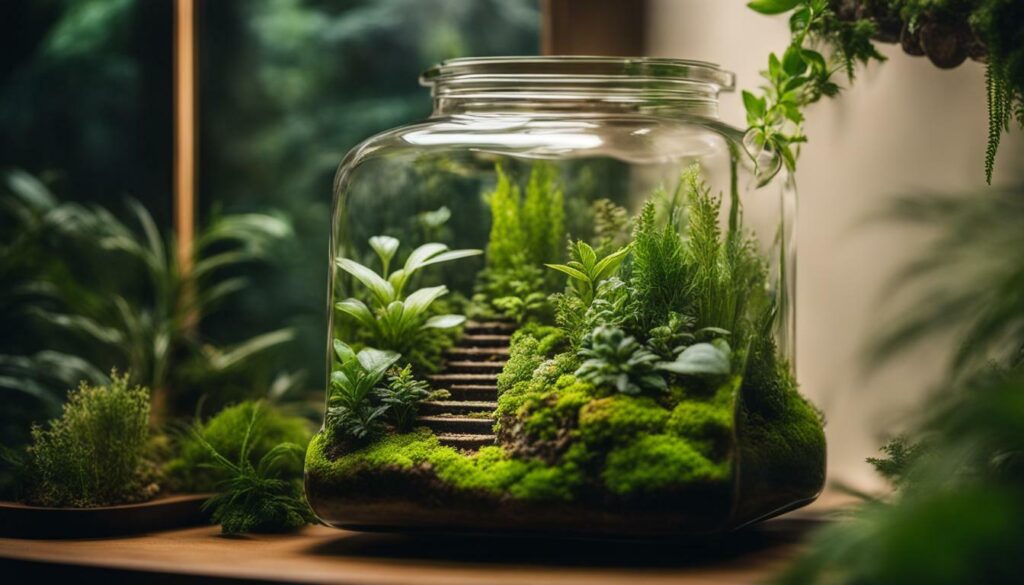
Regular plant maintenance and trimming are essential for the overall health and aesthetics of your terrarium. Let’s learn how to properly care for your plants and keep your terrarium in top condition.
Start by inspecting your terrarium regularly for any signs of rotting or overgrown plants. These can disrupt the balance within the terrarium and lead to the growth of mold and other unwanted organisms. Carefully remove any plants that show signs of rot or disease, ensuring that you remove both the affected leaves and the roots.
In addition to removing unhealthy plants, it’s important to trim back any plants that have become overgrown. This will help maintain the desired shape and size of the plants in your terrarium. Use clean, sharp scissors or pruning shears to carefully trim the excess growth, making clean cuts just above a leaf node or bud.
To maintain a natural and visually appealing appearance, it’s recommended to prune your plants to create different heights and layers within the terrarium. This will contribute to the overall aesthetics and provide a more realistic habitat for your plants and any inhabitants.
| Plant Maintenance Tips | Trimming Tips |
|---|---|
| Inspect your terrarium regularly for signs of rot or disease. | Use clean, sharp scissors or pruning shears to trim back overgrown plants. |
| Remove any unhealthy plants, including the affected leaves and roots. | Make clean cuts just above a leaf node or bud to promote new growth. |
| Prune plants to create different heights and layers within the terrarium. | Dispose of trimmed plant material properly to prevent the spread of disease. |
| Keep an eye out for pests and promptly remove them from your terrarium. | Regularly clean your pruning tools to prevent the spread of disease. |
By following these plant maintenance and trimming tips, you can ensure that your terrarium remains healthy and visually appealing. Remember to dispose of any trimmed plant material properly to prevent the spread of disease. Regularly clean your pruning tools to maintain their effectiveness and prevent the transfer of pathogens. With proper care, your terrarium will thrive and bring enjoyment for years to come.
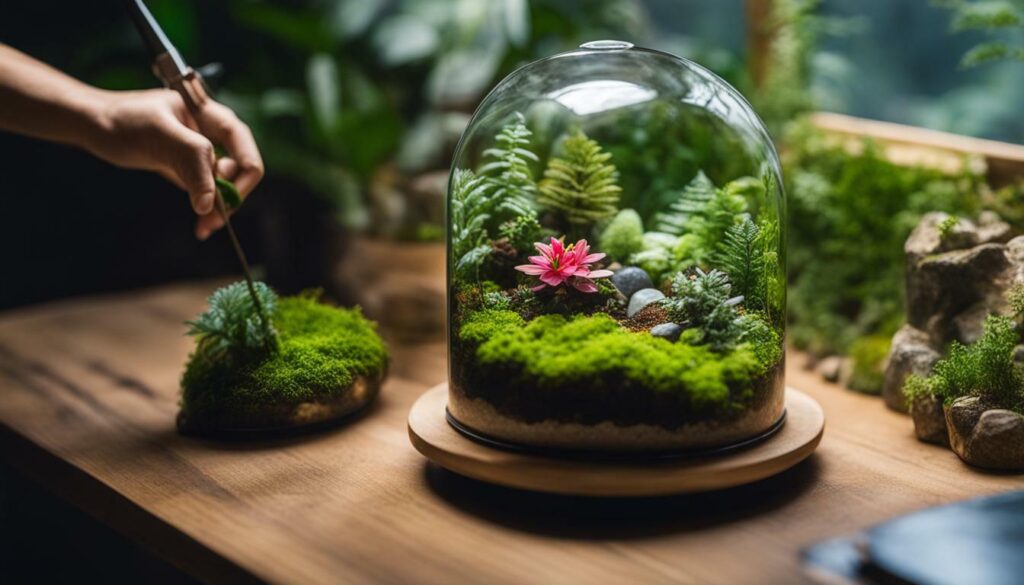
A clean terrarium glass not only enhances the visual appeal of your terrarium but also ensures optimal light transmission. In this section, we’ll guide you through the best practices for keeping your terrarium glass clean.
First and foremost, it’s important to avoid using harsh chemicals or abrasive materials that could damage the glass or harm your terrarium’s inhabitants. Instead, opt for gentle cleaning solutions that are safe for both the glass and the plants. A mixture of mild dish soap and warm water can effectively remove dirt and grime without causing any harm.
When cleaning the terrarium glass, be sure to use a soft cloth or sponge to avoid scratching the surface. Gently wipe the glass in a circular motion, paying extra attention to any stubborn spots or residue. Rinse the glass thoroughly with clean water to remove any soap residue.
Table: Recommended Cleaning Solutions
| Solution | Ingredients | Instructions |
|---|---|---|
| Mild Dish Soap Solution | – Mild dish soap – Warm water | 1. Mix a few drops of mild dish soap with warm water 2. Dip a soft cloth or sponge into the solution 3. Gently wipe the terrarium glass in a circular motion 4. Rinse the glass thoroughly with clean water |
| Vinegar Solution | – White vinegar – Water | 1. Mix equal parts of white vinegar and water 2. Dip a soft cloth or sponge into the solution 3. Gently wipe the terrarium glass in a circular motion 4. Rinse the glass thoroughly with clean water |
Regular cleaning of the terrarium glass is recommended to prevent the buildup of dust and debris. Aim to clean the glass at least once a month or more frequently if needed. Additionally, consider wiping down the glass from the inside as well, especially if you notice any condensation or residue.
By following these simple cleaning practices, you can maintain a clear and visually stunning terrarium that allows your plants and water features to shine. Remember, a clean terrarium glass not only provides a beautiful display but also contributes to the overall health and well-being of your terrarium’s inhabitants.
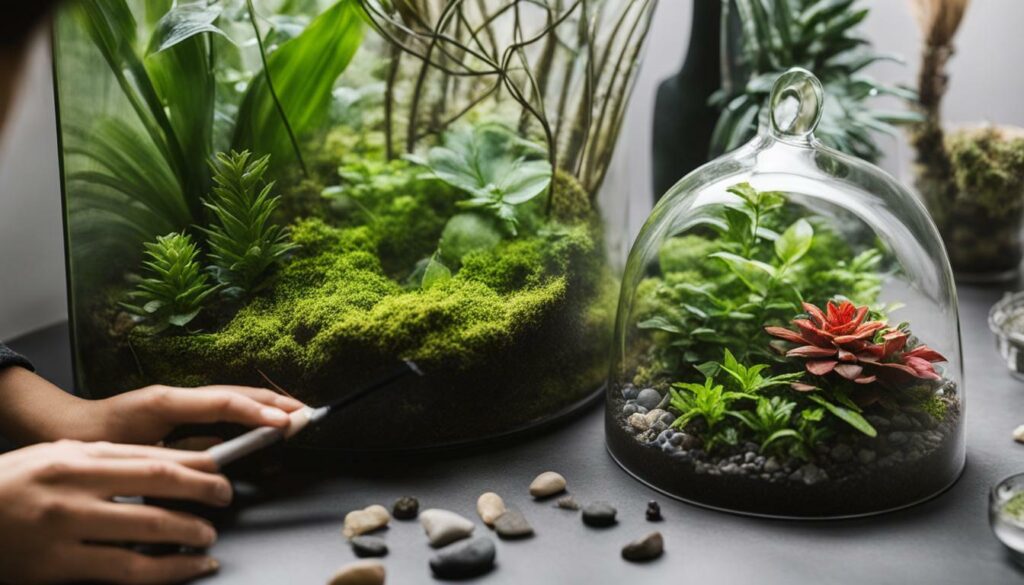
In the next section, we’ll explore the process of creating and maintaining a closed terrarium, including container selection, soilless potting mix, and plant care. Stay tuned for more terrarium care tips!
Creating and Maintaining a Closed Terrarium
Closed terrariums offer a unique and self-sustaining environment for plant growth. In this section, we’ll guide you through the step-by-step process of creating and maintaining a closed terrarium.
To start, select a suitable container for your closed terrarium. A glass vessel with a tight-fitting lid works best to trap moisture and create the ideal humid environment. Next, prepare the soilless potting mix by combining equal parts of peat moss, perlite, and charcoal. This mixture provides adequate drainage and prevents soil compaction.
Now it’s time to select the plants for your closed terrarium. Opt for small, slow-growing plants that thrive in high humidity, such as ferns, mosses, and tropical plants. Arrange the plants according to their size, placing taller ones at the back and shorter ones in the front.
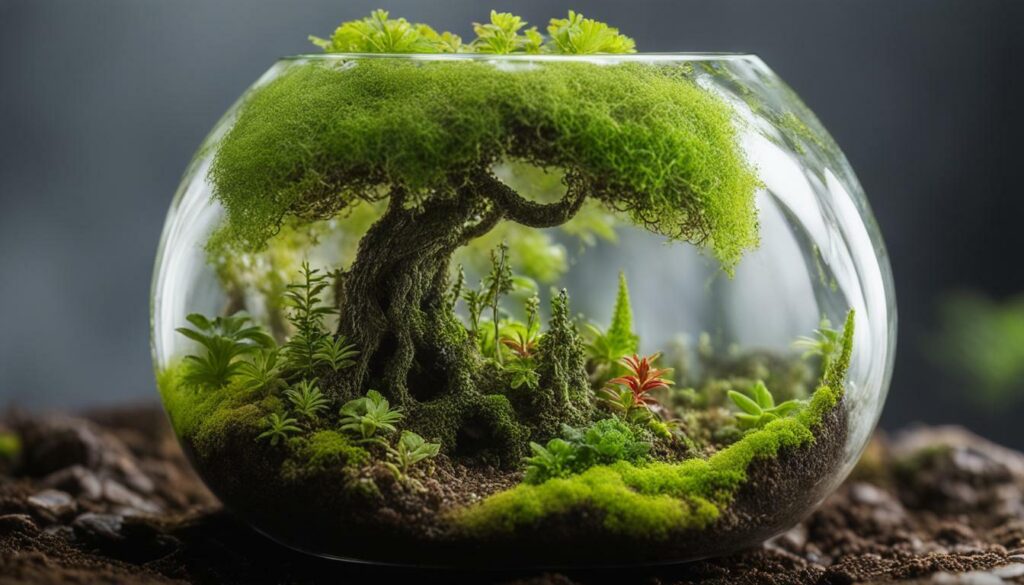
After planting, gently water the terrarium using a spray bottle or mister. It’s important to moisten the soil without drenching it. Remember, closed terrariums are self-sustaining environments, so the water cycle will continuously recycle moisture. Keep an eye on the condensation inside the terrarium, as it indicates a healthy level of moisture. If there is excessive condensation, remove the lid temporarily to allow for proper ventilation.
Maintenance for closed terrariums is minimal. Monitor the terrarium regularly and trim any overgrown or damaged plants to maintain a balanced ecosystem. Keep the glass clean to maximize light transmission and visibility. If you notice any signs of mold or pests, address the issue promptly by increasing airflow and gently wiping affected areas with a solution of hydrogen peroxide or chamomile tea.
| Key Points for Creating and Maintaining a Closed Terrarium: |
|---|
| 1. Select a glass container with a tight-fitting lid. |
| 2. Prepare the soilless potting mix with peat moss, perlite, and charcoal. |
| 3. Choose small, slow-growing plants that thrive in high humidity. |
| 4. Arrange plants based on size and watering requirements. |
| 5. Water the terrarium gently using a spray bottle or mister. |
| 6. Monitor condensation levels and adjust ventilation if necessary. |
| 7. Trim overgrown or damaged plants regularly. |
| 8. Keep the glass clean for optimal visibility and light transmission. |
| 9. Address mold or pest issues promptly with proper cleaning methods. |
Paludarium Care
Paludariums provide a captivating blend of aquatic and land terrarium elements, requiring specific care and maintenance. Let’s explore the key factors for successfully caring for a paludarium.
Water feature care in a paludarium is essential for maintaining the health and beauty of the aquatic environment. Regular monitoring and maintenance of water quality is crucial. It is recommended to test the water parameters regularly and make adjustments as needed. Maintaining proper pH levels and ensuring adequate filtration are important aspects to consider.

Plant selection is another important consideration in paludarium care. Choosing plants that thrive in both aquatic and terrestrial environments is key. Some popular choices include ferns, mosses, and other moisture-loving plants. It is important to research the specific needs of each plant and ensure they are compatible with the paludarium’s conditions.
Decorative materials play a significant role in creating a visually appealing paludarium. Rocks, driftwood, and other natural elements can be used to create a realistic habitat for both aquatic and land-dwelling organisms. It is important to choose materials that are safe for the inhabitants and resistant to water damage.
| Water Feature Care Tips |
|---|
| Regularly monitor and maintain water quality |
| Choose plants that thrive in both aquatic and terrestrial environments |
| Use safe and water-resistant materials for decoration |
In conclusion, proper care and maintenance are essential for the success of a paludarium. By monitoring water quality, selecting suitable plants, and using appropriate decorative materials, you can create a thriving ecosystem that combines the beauty of aquatic and terrestrial elements.
Water Quality and Substrate Maintenance for Paludariums
Maintaining a healthy water feature in your paludarium requires careful attention to water quality, substrate maintenance, lighting, and overall maintenance. Let’s dive deeper into these essential aspects of paludarium care.
To ensure optimal water quality, regular monitoring is necessary. Keep an eye on the pH levels, ammonia levels, and temperature of the water. Test kits are available that can help you maintain the ideal balance for your aquatic plants and animals. It’s important to establish a regular water change schedule to prevent the build-up of harmful substances and ensure a clean and healthy environment for your paludarium inhabitants.
When it comes to substrate maintenance, choosing the right substrate is crucial. Aim for a mixture of aquatic soil, sand, and gravel to provide a suitable environment for both plants and aquatic creatures. Regularly check the substrate for any signs of decay or debris accumulation, as these can lead to water contamination. Siphoning the substrate during water changes can help remove any unwanted debris and maintain a clean and balanced ecosystem.
Proper lighting is essential for the health and growth of aquatic plants in your paludarium. Different species of plants have varying lighting requirements, so research the specific needs of your plants and provide appropriate lighting levels and duration. Use a timer to ensure consistent lighting cycles and avoid excessive exposure, which can lead to algae overgrowth. Also, be mindful of the placement of your lights to avoid shadows or uneven lighting throughout the paludarium.
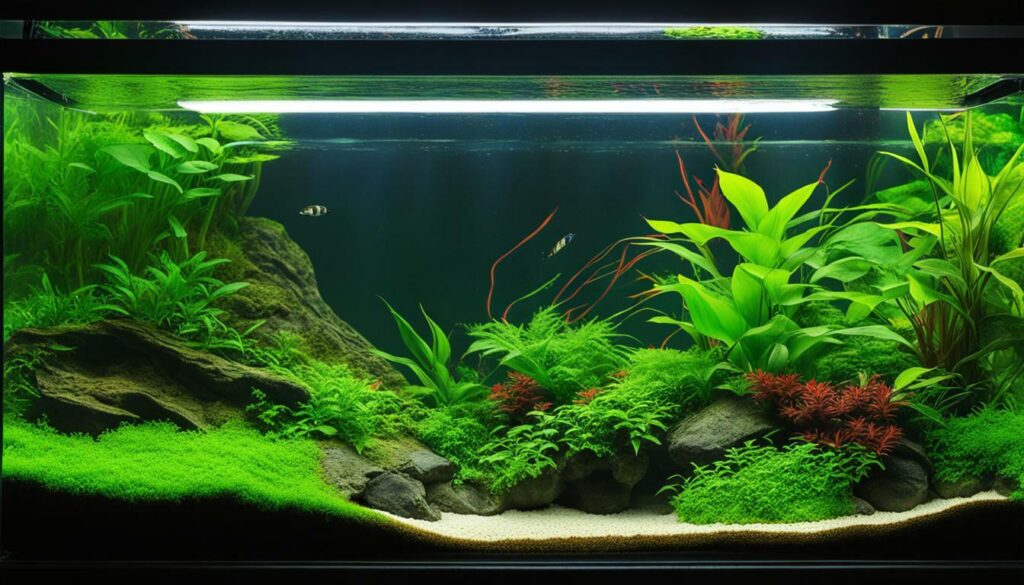
In summary, maintaining a paludarium’s water feature involves regular monitoring of water quality, maintaining the substrate, providing proper lighting, and overall maintenance. By paying close attention to these aspects, you can create a thriving ecosystem for your aquatic plants and animals in the paludarium.
How Can I Prevent Disease in my Terrarium and Water Feature?
Proper terranium care disease management is essential to prevent disease in your terrarium and water feature. Ensure good air circulation, proper watering, and regular cleaning to prevent the buildup of harmful bacteria and fungi. Use disease-resistant plants and monitor for any signs of illness in your terrarium.
Congratulations on completing our comprehensive guide to terrarium care and water feature care!
By following the expert tips and techniques provided, you are well-equipped to maintain the beauty and health of your terrariums and water features. Mastering terrarium care requires attention to humidity levels, watering practices, lighting conditions, and prevention of mold growth.
Checking the humidity of your terrarium is crucial, and you can easily do this by observing condensation on the terrarium glass. This will help ensure that the environment is ideal for your plants and aquatic life.
When it comes to watering, it’s important to avoid overwatering, as this can lead to root rot and other issues. Instead, use a mister or spray bottle to provide a gentle misting of water. This will help maintain the right level of moisture without saturating the soil.
Proper lighting conditions are also vital for the health of your terrarium. Bright indirect light is preferred, as it provides the necessary energy for photosynthesis without causing overheating or sunburn. Be sure to balance light exposure and monitor any changes in plant growth.
To keep mold growth at bay, increase airflow within your terrarium by removing any obstructions and opening the lid occasionally. If mold does appear, wipe affected areas with hydrogen peroxide or chamomile tea, which have natural antifungal properties. Introducing springtails, tiny beneficial insects, can also help prevent mold outbreaks.
Regular plant maintenance and trimming are essential for maintaining balance and preventing mold blooms in your terrarium. Remove any rotting plants and trim overgrown ones to ensure optimal growth and wellness.
Keep the terrarium glass clean to maximize visibility and light transmission. Regularly wipe down the glass with a soft cloth or use a glass cleaner formulated for aquatic environments to remove any smudges or buildup.
If you’re interested in creating a closed terrarium, carefully consider the container, soilless potting mix with charcoal, plant selection, and placement. Regular cleaning and occasional watering will be necessary to maintain the delicate balance within the closed environment.
For those looking to delve into the world of paludariums, combining aquatic and land terrariums, waterproof containers, filtration systems, climbing areas, and appropriate plant and decorative material selection are crucial. Remember to monitor water quality, utilize proper substrate, and provide adequate lighting for the well-being of your paludarium.
Thank you for joining us on this journey to becoming a terrarium and water feature care expert. We hope you continue to enjoy the beauty and serenity that these miniature ecosystems bring to your home or office.
FAQ
What are the key factors to consider for terrarium care?
Mastering terrarium care requires attention to humidity levels, watering practices, lighting conditions, and prevention of mold growth.
How can I check the humidity levels in my terrarium?
The humidity levels can be checked by observing condensation on the terrarium glass.
What is the best way to water a terrarium?
Overwatering should be avoided, and a mister or spray bottle can be used for watering.
What kind of lighting conditions are ideal for a terrarium?
Terrariums should receive bright indirect light, striking a balance between sufficient light and not too much light.
How can I prevent mold growth in my terrarium?
Mold can be controlled by increasing airflow, wiping with hydrogen peroxide or chamomile tea, and introducing springtails as a preventive measure.
How important is plant maintenance and trimming in terrarium care?
Plant maintenance and trimming are essential for maintaining balance and preventing mold blooms.
How do I clean the terrarium glass for maximum visibility and light transmission?
The terrarium glass should be kept clean using effective cleaning techniques.
What are the key considerations for creating and maintaining a closed terrarium?
Creating and maintaining a closed terrarium requires careful consideration of container choice, soilless potting mix with charcoal, plant selection, placement, and occasional cleaning and watering.
What does paludarium care involve?
Paludarium care involves maintaining waterproof containers, filtration systems, climbing areas, and proper plant and decorative material selection for wet conditions.
What should I consider for water quality and substrate maintenance in paludariums?
Monitoring water quality, utilizing proper substrate, lighting, and general maintenance are important for paludarium care.

